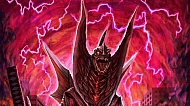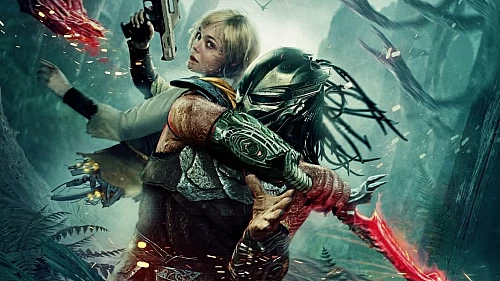(Author's note: This article was written a couple of weeks ago without anticipating the announcement of Pacific Rim 2. With the sequel's release date confirmed, and a weekend full of giant robots about to dominate the boxoffice, it seemed like the appropriate time to post it. Enjoy.)

In a recent article I pointed out Godzilla (2014), despite its flaws, largely worked by embracing franchise norms and using the concepts to further its themes. Many of my comparisons, however, were not directly tied to Ishiro Honda's Godzilla movies. (Although I made one note of Terror of MechaGodzilla. [1974]) While director Gareth Edwards claims to have derived much from 1954's Godzilla, his film doesn't quite feel like anything Honda concocted.
Ishiro Honda not only birthed the Godzilla series, he launched a fleet of Japanese science fiction/fantasy with a lineage seen in the likes of Super Sentai, Kamen Rider and Ultraman today. Honda was not only responsible for directing the best of the Godzilla series, but some of the most imaginative and acclaimed in the genre: Rodan (1956), The Mysterians (1957), War of the Gargantuas (1966), etc. Though he preferred general science fiction to monster pictures he always found a way to sneak his ideals into a project.
One of the most lauded examples is found in Monster Zero (1965). (a.k.a. Invasion of Astro-Monster) Although it was his fifth Godzilla picture, Honda blended it with his love for interstellar storytelling and created a pulp sci-fi flick many considered one of the best in the series. It carried Honda's trademark theme of unity-- Enemies and foes coming together to achieve victory; a world uniting to oppose a great threat.

Guillermo del Toro's Pacific Rim (2013) likely makes a better case for Honda's favorite themes than Edwards' Godzilla. Unity on a personal level was just as important to Honda as it was on a global scale. In Monster Zero Fuji (Akira Takarada) eventually approves of his sister's boyfriend, Tetsuo, (Akira Kubo) after he reveals his invention can be weaponized. The Mysterians' Dr. Shiraishi (Akihiko Hirata) makes amends with Atsumi (Kenji Sahara) and Iwamoto (Momoko Koichi) before making the ultimate sacrifice to save the world--These examples echo the characters in Pacific Rim: Raleigh (Charlie Hunnam) and Chuck (Robert Kazinsky) accept each other as allies, Hermann (Burn Gorman) and “Newt” (Charlie Day) put aside their rivalry, etc. There's a sense of rejecting petty differences for a greater good and that's exactly the kind story Honda loved to tell.
Honda's films rarely delved into the political stratagem of aligning countries, but he was optimistic it could work if the stakes were high enough. Characters overcoming disparity reflected these alliances, postulating if enemies can become friends on a personal level it might work globally. The naivety behind Honda's optimism is not lost, but if something as fantastic as aliens and monsters threatened mankind's existence might it be enough to unite the world? Guillermo del Toro thought so.

Pacific Rim is a film with unbridled optimism. Before the opening battle mankind has already united for war. (Including the often villainized China, which is one of the stronger allies.) Like Honda's movies it ignores the political ramifications of unison and focuses on characters attempting to save a world under their own ingenuity. This is precisely what Monster Zero, The Mysterians, Rodan and Battle in Outer Space (1959) does. These stories put faith and power into the people and allow them to overcome differences for a greater cause.
Honda had very little use for politicians and military leaders in his films. The quibbling amongst groups in the National Diet Building from Godzilla rides on the criticism of political parties and groups fighting each other more often than solving problems. The room in which the argument takes place is later destroyed by Godzilla, underlining the usefulness of government squandering. Likewise, del Toro is quick to write off political decisions as valuable. When Stacker Pentacost is told by multiple representatives that the Jaeger program is shut down he announces to his team, “We don't need them.” Honda enjoyed spending more time satirizing political systems, but Pacific Rim makes the same point in four words. From there it's up to del Toro's colorful cast of characters to take on the kaiju threat.
By comparison, Edwards' Godzilla doesn't have the same character dynamics that del Toro and Honda gave their kaiju romps. Instead it uses its cast as a perspective to view the monsters--There's very little conflict to solve with unison. The film's best example of unity is its emphasis on family. Although humanity is humbled by nature's power to send our world awry there's an overarching idea that human camaraderie is enough to survive its wrath. The family running from Godzilla's tsunami, the asian couple in Hawaii and Ford's (Aaron Taylor-Johnson) family were all survivors living for someone else. Meanwhile, Joe Brody (Bryan Cranston) only lived for a memory, perhaps alluding that it wasn't enough to keep him out of harm's way. It's not an absolute rule and it doesn't speak to universal unity, but it hints at larger themes for humanity's survival. To be ever so contrived, “love conquers all."

Honda's films also aimed to be a great deal of fun and while I think Godzilla is plenty entertaining, Pacific Rim was more deliberate with its shenanigans. “I didn't want to make a war movie I want to make an adventure movie,” said del Toro, “And my idea would be kids come out of the theater and want to be Jaeger pilots.”* Eight years after the original Godzilla Honda returned to the series and embraced camp with King Kong vs. Godzilla (1962). From there he created a slew of 1960s pictures that used campy absurdities to their advantage--Building an entire franchise on the concept. Producer Tomoyuki Tanaka helped him widen the audience for these films and it birthed the Golden Age daikaiju eiga. Pacific Rim is an obvious throwback to this decade of fun, Japanese special effects cinema. To great success, Guillermo del Toro uses camp to energize the look and feel of his movie much like Honda did. The current Godzilla doesn't altogether reject camp, but chooses not to revel in it either-- A choice that's not so much a positive, but a notable stylistic decision.
In addition to an emphasis on universal unity, Pacific Rim utilized Honda's penchant for strong female characters in Mako Mori (Rinko Kikuchi) and handling romance with a sense of physical detachment. Mako Mori has been cited as a beloved female character breaking free of a world dominated by men-- Stacker Pentacost (Idris Elba) in particular. While she doesn't quite pass the Bechdel test critics have suggested another feminist exam be named after her character.**

Like Mori, Honda wrote female characters that made strong impressions: Nakanishi (Yuriko Hoshi) humbling Infant Island's natives to save her country, (Mothra vs. Godzilla [1964]) and Princess Salno's (Akiko Wakabayashi) Venusian persona suggesting borderline vengeful, female dominance with her prophesies in Ghidorah: The Three-Headed Monster (1964). Of course Emiko, of the original Godzilla, became the defining variable to defeating the monster. She broke social rank, and a promise, to reveal Serizawa's dangerous Oxygen Destroyer. Many of these acts seem pale in comparison to Mori's arc, but for the time frame they said a great deal about a populace in social transition. Meanwhile, female characters are the first to be forgotten in Edwards' Godzilla. It's not deliberate misogyny, but neither Elle (Elizabeth Olsen) or Dr. Graham (Sally Hawkins) stand out with notable contributions to the story's endgame.
Cultural significance is a large part of what makes these movies so rich and with that in mind it's important to note that Honda's films are ultimately Japanese. They were created for Japan's cinema-going audience as entertainment with a silver lining. Pacific Rim, on the other hand, is not a Japanese film. However, it embodies much of what Honda churned out in the 1960s--The Golden Age of Japanese giants. The current Godzilla doesn't quite have that same flare. It passes the bar as a modern Godzilla effort, but Pacific Rim jumps it as an ode to the genre's finest director.
Follow GMAN on Twitter: @GMANonScified
-----------
*Guillermo del Toro Talks Getting Back in Director's Chair...
**The Mako Mori Test: 'Pacific Rim' inspires a Bechdel Test alternative

Giladio: The Giant Monster – A New Kaiju from Japan by Yoshikazu Ishi!
From Japan comes a brand new Kaiju movie featuring a monster named Giladio and its being produced on an $11,000 budget, written and directed by Yoshikazu Ishi!

Carranger Hits Shelves in April!
Shout!Factory has recently been pumping out classic Super Sentai series for the west. First came Zyuranger (the basis for Mighty Morphin' Power Ranger...

Ultraman Orb: The Origin Saga Full Trailer
The exciting series finale of Ultraman Orb aired this past Friday, but today Amazon Japan releases the first episode of the saga that led up to the se...

Ultraman Orb: The Origin Saga Teaser Released
Although the main Ultraman Orb series is winding down, the character will continue to be in the spotlight with the upcoming film, Ultraman Orb: The Mo...

Ultraman's 50th Anniversary Film Hitting US Theaters as Double Feature!
SciFi Japan just announced the incredible news that Japan's greatest hero is hitting theaters for a limited release this winter. The 50th Anniversary ...




